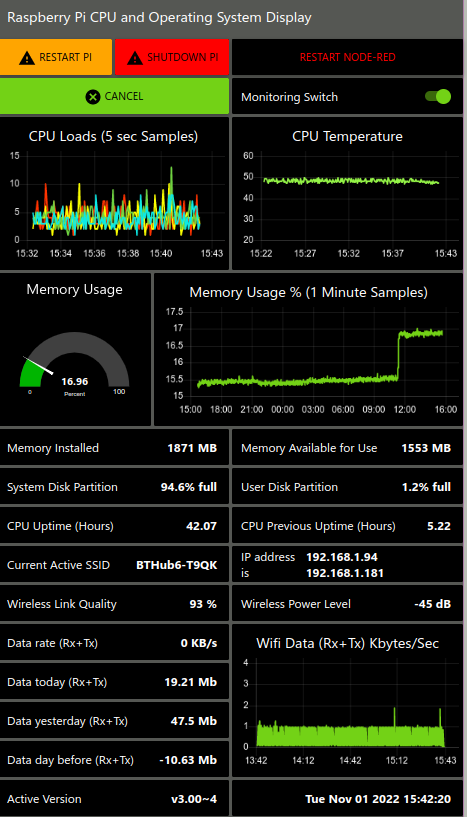Just wondering I just installed Venus on a Raspberry Pi 4b and would like to know if there is a setting or way to monitor its CPU temperature?
- Home
- Anonymous
- Sign in
- Create
- Spaces
- Grafana
- Node-Red
- Unsupported topics
- Questions & Answers
- Modifications
- Communauté francophone
- Deutschsprachiger Bereich
- Preguntas en Español
- Explore
- Topics
- Questions
- Ideas
- Articles
- Badges
question
@friaras@gmail.com I use Node-RED and add node-red-contrib-cpu which provides cpu loads and temperature as part of comprehensive dashboard of diagnostics. node-red-contrib-os provides a lot more useful information on the OS. Node-RED is part of Venus OS Large. The diagnostics tab for my Pi4b is below.

@friaras@gmail.com Node-RED takes while to get used to - I wrote some notes when I started which may help you:
Node-RED works on the basis of a pictorial workspace where you can drag a selection of nodes from a palette on the left of the workspace and connect them together by dragging from a nodes output to another's input. What this is doing is connecting a series of messages between outputs and inputs each of which has a payload. In essence these streams of messages are asynchronous and everything is event driven. To the right of the screen is a multi purpose sidebar (panel) which can display debug information, help and several other panels useful for configuration and diagnostics and importantly it allows one to configure a separate Dashboard - a User Interface (ui) to display and control the system.
Nodes can generate messages, change messages as they pass through (a function node) and display messages on the dashboard amongst many other things. The display nodes are very powerful and it is as easy to display on a dial or graph as a number on a dashboard.
The Display Nodes (Dashboard) are not installed by default and have to be added - at the top right is a menu (three horizontal bars) and you need Manage Palette and search for node-red-dashboard on the Install tab and Install - you will then find a suite of powerful display nodes in the left hand panel. Other useful nodes that can be added the same way.
Victron devices such as a Victron Solar Charger are added as nodes by default and you end up with multiple instances as each input and output from a device is added as a separate node - most nodes only have a single input and/or output so, for example, the the output representing solar power is a series of messages every 5 seconds. You add another copy of the Victron Solar node and set it up internally to say give the state which will be another series of messages every 5 seconds.
When one comes to use Node-RED one has to understand one fundamental difference from most programming one has done before. Node-Red is about flows. It is about messages with payloads being passed so in many ways it is transitory. An instrument produces a series of messages at regular intervals rather than a set of variables you work on. A good example is a panel switch node on your dashboard. When you turn it from off to on it sends a single message of true and a single message false when you turn it off. It can be used to carry out an action immediately by a device which responds to a single message such as 'turn inverter on'. But if you want to use that message to change anything in the future the true or false has to be captured. This takes a quite a bit of getting used to the first time.
@friaras@gmail.com It would not take my full answer so part 2!
Recent versions of node red have a feature called 'context' which provides the ability to save a value in the equivalent of the more usual variable and access them again with various scopes and even save them on a regular basis to a file to preserve them across restarts.
The workspace is at venus.local:1881 and the ui at venus.local:1881/ui on a local network and is secure (https) under the Victron OS - it is usually on port 1880 and is not https
Related Resources
Additional resources still need to be added for this topic
Raspberry Pi running Victron’s Venus firmware - Blog Post
Venus OS Large image: Signal K and Node-RED - Install
raspberrypi install venus image
question details
54 People are following this question.
